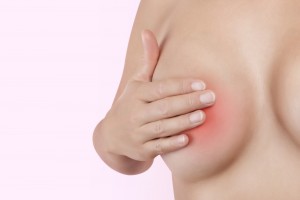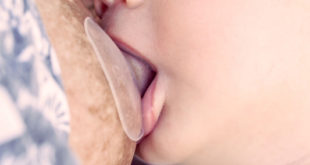 Sore nipples are one of the most common reasons new mothers give for discontinuing breastfeeding, often during the first week of nursing. This is quite unfortunate, for nipple soreness is almost always a short-term problem, and can usually be corrected in a matter of days. Breastfeeding isn’t supposed to hurt, but the fact of the matter is that most mothers will experience some degree of soreness during the early stages of nursing. The degree of soreness varies greatly, with some mothers experiencing slight tenderness, and others bleeding, cracked nipples.
Sore nipples are one of the most common reasons new mothers give for discontinuing breastfeeding, often during the first week of nursing. This is quite unfortunate, for nipple soreness is almost always a short-term problem, and can usually be corrected in a matter of days. Breastfeeding isn’t supposed to hurt, but the fact of the matter is that most mothers will experience some degree of soreness during the early stages of nursing. The degree of soreness varies greatly, with some mothers experiencing slight tenderness, and others bleeding, cracked nipples.
It is common to feel some discomfort when the baby first latches on, especially in the first days after birth before the milk has come in. This type of soreness will usually ease up after the first few sucks, especially after the milk lets down and flows freely. Remember that your nipples are a very sensitive part of your body, and are not used to having stress put on them. Perhaps women in primitive societies, whose breasts were exposed to air and sunlight constantly, experienced fewer problems with soreness. However, in our modern society, nipples are constantly protected and covered.
A newborn baby has an amazingly strong suck for such a tiny person – put your finger in a baby’s mouth, wait for him to start sucking, and then try to pull it out. It’s a lot like a snapping turtle! It’s not surprising that it takes a while for your delicate nipple tissue to adapt to this new experience.
You and your baby both have to learn how to breastfeed. This may come as a surprise, since lower mammals (such as rats and cats) know how to do it instinctively. However, as we move up the evolutionary scale, we find that primates (apes and monkeys) also have to learn how to breastfeed. In fact, gorillas in zoos who have never seen another gorilla nurse have been taught how to breastfeed by watching videos, and even bringing in other nursing mothers (sometimes human ones!) to show them the ‘how tos.’
Babies are born with a strong sucking reflex (they even suck their fingers in utero), but they have to learn the mechanics of breastfeeding, at the same time you are learning the mechanics of positioning, supporting the breast, etc. While some babies seem to come into the world knowing just how to breastfeed correctly, more often it is a learning process for both of you.
Nipple soreness will usually begin during the first few days of nursing, will peak on the fourth or fifth day, and then ease off each day after that. Soreness should lessen greatly on days 7-10, and by the time the baby is 2 weeks old, nursing should be pain free. If your nipples crack or bleed, if the pain persists during the entire feeding or between feedings, if you experience a burning sensation, or the pain persists beyond the first week or two. you need to seek help from an IBCLC (International Board Certified Lactation Consultant) or health care provider (HCP) who is knowledgeable in breastfeeding in order to identify and correct the problem.
By far the most common cause of nipple soreness is improper latch on and positioning. Remember that the baby has to learn how to nurse correctly. It can take awhile for a newborn, with his immature system, to master the mechanics of nursing. The slightest improper movement of his lips, tongue, or gums can abrade the nipple tissue and cause soreness. With every feeding, he will be better able to coordinate his movements, and will soon get the hang of nursing correctly and efficiently.
Here are the basics of correct latch on and positioning, which can minimize or eliminate soreness:
- The classic cradle hold is the most common nursing position. Sit upright in a comfortable chair, with a pillow supporting your back, one under the arm holding the baby, and another in your lap to bring him up to the level of your breast. You will be spending a lot of time in this position, so make sure that you are comfortable, and are not straining the muscles in your arm, neck, shoulder, or back.
- Your baby should be positioned on his side, with his whole body facing yours. He should not have to turn his head to reach your breast (try turning your head to one side and swallowing – you’ll be surprised at how difficult it is to do).
- Cradle his head in the crook of your arm, with his body along your forearm and your hand cupped under his thighs or buttocks. His ear, shoulder, and hip should be in a straight line
- When you offer your breast, use your free hand to support it with your thumb on top and hand underneath, forming a “C”. Make sure your thumb and fingers are behind the areola (the dark area around the nipple). Gently stroke his lower lip with your nipple – this will encourage him to reflexively open his mouth. Wait for him to open wide, like a yawn, then quickly pull him in close with the arm that is supporting him. Bring him to the breast rather than pushing the breast toward him.
- His mouth should cover a large portion of the areola (at least an inch). If your areola is large, his mouth may not cover the entire area, but he should be far enough back on the areola so that his gums bypass the nipple and compress the milk sinuses underneath the areola. The nipple should be centered in his mouth, above his tongue. His lower lip should be covering more of the areola than his upper lip.
- He should be pulled in close so that chin and nose touch your breast. Don’t be afraid that he won’t be able to breathe – that’s why newborns have little pug noses and receding chins. I can’t remember the last time I saw a story in the news about a baby suffocating at his mother’s breast. Can you? If his nose does seem to be blocked, lift your breast or pull him in closer to you. If you press down too firmly on the top of the breast to create an airway, you may pull the nipple to the front of his mouth, which can cause nipple soreness.
When a baby is latched on correctly, his lips will be flanged out (not sucked in – if he tends to suck in his lip, just gently pull it out), and the nipple will be far back in his mouth, with his tongue extended over his gums and underneath the nipple. In this position, you will feel a pulling and tugging sensation as he compresses the milk sinuses, but there will be no way for his tongue, gums, or lips to abrade your nipple tissue.
- If he is nursing correctly, you should feel little or no pain. If he seems to be latched on incorrectly, or if nursing hurts, don’t be a martyr. Slip your finger in the corner of his mouth to break the suction, take him off the breast, and start over. Don’t let him continue to nurse incorrectly. Keep trying until you get it right. If you get frustrated, stop for a minute and try again when you are calmer. You may want to give him your finger to suck until he settles down. Most babies will get the hang of latching on correctly within a couple of days.
- Changing nursing positions is not always necessary. Many mothers find a position that feels comfortable for them, usually the cradle hold, and use it exclusively – I nursed six babies and never used any other position, other than nursing lying down for night feedings – this position is the most difficult to master, but can be a great survival technique for the mother of a baby who nurses frequently during the night. If your nipples are extremely sore, alternating positions has the advantage of putting pressure on different parts of the nipple. The football, or clutch hold, is another popular nursing position. It is especially useful for the mother who has large breasts, flat or inverted nipples, or who has had a cesarean birth (no pressure on the incision). This hold offers the advantage of a clearer view of your baby, and good control of his head. To position your baby in the football hold, use pillows to raise the baby up to the level of your breast. Hold his head in the palm of your hand and tuck his legs under your arm, close to your body. His buttocks will be up against the back of the chair or bed with his legs flexed upward. Remember, whatever position you are using, keep him pulled in close so that he can pull the nipple far back into his mouth and nurse effectively.
Most cases of nipple soreness are caused by improper latch on and positioning and will heal within a matter of days once the baby is nursing properly. Another common cause of soreness is engorgement: when the breasts become so full of milk that they are hard and tight, the nipple may flatten out (imagine a water balloon) and difficult for the baby to grasp. The baby may not be able to pull the nipple far enough back in his mouth to effectively compress the sinuses behind the areola. Try to avoid engorgement by nursing frequently. When your nipples are sore, there is a tendency to avoid nursing often, but this only compounds the problem. There is no advantage to limiting sucking time at the breast, as newborn babies need to nurse often (10-12 times or more in 24 hours) to encourage milk production and to satisfy their sucking needs. If your baby is latched on correctly, it doesn’t matter how often or how long he nurses, it shouldn’t hurt. If he isn’t latched on correctly, even one short feeding can cause nipple damage. If your breasts do become engorged, try massaging your breasts, applying heat, and expressing a small amount of milk before offering the breast to soften the areola and make it easier for him to grasp hold of.
There are other causes of soreness, however, which are less common. These include:
Pregnancy: See Article Nursing During Pregnancy and Tandem Nursing
Flat or Inverted nipples: See Article Flat or Inverted Nipples
Yeast Infection (Thrush): See Article Yeast Infections and Thrush
Tongue Tie: See Article Tongue Tie
Nipple confusion: Some babies switch back and forth from breast and bottle beautifully from day one with no complications. However, the mechanics of breast and bottle-feeding are quite different, and it is best to avoid introducing artificial nipples until the baby has mastered the mechanics of nursing at the breast. With an artificial nipple, the baby uses his tongue to press against the hard rubber to control the steady flow of milk, and may try to do the same thing when he pulls his mom’s soft, mushy nipple into his mouth. This can cause his tongue to rub against the nipple and make it sore. It is best, if possible, to avoid the use of bottle nipples or pacifiers until the baby has become well established at breastfeeding.
- Vary nursing positions to put pressure on different parts of the nipple.
- The baby’s sucking is strongest when he first latches on. You may want to numb the nipple slightly by applying ice before putting the baby on the breast. Don’t apply the ice directly – wrap it in a cloth or towel first.
- Begin nursing on the least sore side first until the milk lets down, then gently switch to the other breast. Use relaxation breathing until your milk lets down. You may want to use massage, warm compresses, and gentle hand expression to stimulate the let-down before you put baby on the breast so that he doesn’t have to suck vigorously while he waits for the milk to let down.
- Express a little colostrum or milk onto your nipples after nursing and let it dry. Human milk has anti-bacterial properties.
- If your nipple has cracked, dab some hydrogen peroxide onto the crack with a Q-tip. This will help kill the bacteria from the baby’s mouth which can enter through the opening in the skin and cause infection. Don’t be shocked if your nipples bleed and your baby swallows some of the blood. As gross as this may sound, the small amount of blood will not hurt the baby. Remember that the two of you shared a blood supply for nine months. Also, haven’t you ever cut your finger and sucked on it till the bleeding stopped? I mention this only because the milk may show up in the baby’s stool or spit up, and before you panic, be aware that if your nipples are cracked and bleeding, the blood is probably yours and not the baby’s. You should always call the doctor if blood appears in your baby’s spit-up or stool, as it may be due to other causes, such as ulcers or allergies. If you see bright red blood, clotted blood, or large amounts of blood you should contact your doctor or go to the emergency room right away.
- Apply modified anhydrous lanolin after nursing ( Lansinoh or Purelan). Surface dampness can contribute to soreness and cracking if the nipple remains moist after nursing, sort of like the way your chapped lips get worse if you lick them. Applying lanolin can help keep the skin soft and pliable, which helps breaks in the skin heal without forming a hard scab which will break open each time the baby nurses. Avoid using other creams on your nipples, including Bag Balm (great for cows, not for humans) and Vitamin E. Don’t use soap on your nipples as it can dry the skin. Bathing with clear water is all you need to keep your nipples clean.
- Glycerin based hydrogel pads like Ameda’s ComfortGel and Lansinoh’s Soothies can accelerate ‘moist wound healing’ by keeping the sore nipple from forming a hard scab. Scabs act as a natural dressing, but the wound underneath them heals more slowly because new cells don’t move as fast into the center of the wound, so it takes longer for it to close. Wounds inside the body heal faster in a moist environment. The hydrogel dressing doesn’t make the skin soggy (like wet nursing pads would), but by encouraging the growth of new skin cells, it can speed up healing by as much as 50%. Have you ever noticed that wounds in your mouth heal faster than wounds on your skin? The pads can be put in the fridge before application, and the cool sensation is very soothing. You don’t really need the pads if your nipples are just sore, but if they’re cracked and the skin is broken, they can be a lifesaver. I recommend that expectant moms get a pair or two to have on hand before the baby arrives, just in case she needs them. They aren’t very expensive, can be used for several days(all the time most nursing moms need to get through the worst of the soreness stage), and feel wonderful even if the skin isn’t broken and the nipples are just tender. If you end up not needing them, they’ll keep for the next baby, or you can pass them on to a breastfeeding friend, My daughter had her first baby a few months ago, and on day two, we sent her hubby to the drugstore to pick up some Soothies. I had planned to bring some with me when the baby was born, but she decided to come a little early and took us all by surprise. My daughter’s nipples were a little sore and tender for a day or two, but never actually cracked. She loved the Soothies, though. We got two pairs so that we could keep one in the fridge and rotate them.
- Expose your nipples to air as much as possible. Leave the flaps on your bra down, and if the weather permits, expose them to sunlight for a few minutes each day. I emphasize a FEW minutes – there are few things more painful than sunburned breasts. Using a hair dryer on a low setting after feedings can help, too.
Try to keep your perspective when dealing with nipple soreness. It usually clears up within a few days, and rarely reoccurs once your baby and you get the hang of nursing effectively as a team. It always makes me sad when mothers quit nursing because of soreness, because the long-term benefits of breastfeeding far outweigh the short- term pain. It really is worth hanging in there – ask any nursing mother, and she’ll tell you she’s glad she didn’t give up when the going got rough.
Anne Smith, IBCLC
Breastfeeding Basics
(Edited September, 2015)
*Please ‘Pay it Forward’!*
If you found any of the information in this article, helpful, please consider making a small donation to my favorite cause – Project Pets: Spay, Neuter, Love – all volunteer, non-profit organization that provides free spay and neuter services for homeless rescue dogs and cats…because every baby deserves a home, whether they have two legs or four! To find out how you can help, visit Project Pets on Facebook.
 Breastfeeding Basics
Breastfeeding Basics





One comment
Pingback: Ask an Expert: Weaning From a Nipple Shield